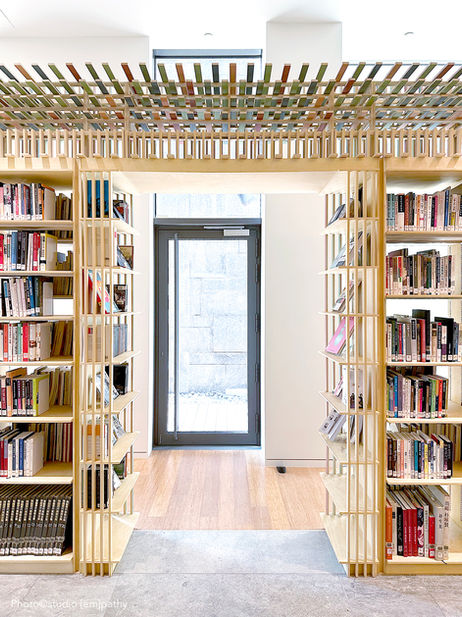STUDIO EMPATHY
[News]
11/2025: Awarded FRAME Awards 2025 Shortlisted & Silver, NL
10/2025: Honored GRANDS PRIX DU DESIGN Awards Grand Winner, CA
06/2025: Awarded AZ Awards 2025 Award of Merit, CA
05/2025: Awarded 2025 NYCxDESIGN Awards Honoree, US
04/2025: Honored Red Dot Design Award: Product Design 2025, DE
03/2025: Honored iF Design Award 2025, DE
12/2024: Awarded Best of Year 2024 Honoree from Interior Design Magazine, US
10/2024: The Library design featured in Dezeen, UK
Korean Cultural Center New York Library - Assembled Void
AWARDS
Red Dot Design Awards 2025
iF Design Awards 2025
GRANDS PRIX DU DESIGN Awards, Grand Winner & Gold Certification
FRAME Awards 2025. Shortlisted & Silver
AZ Awards 2025, Award of Merit
NYCxDESIGN Awards 2025, Honoree
Interior Design Magazine Best of Year 2024, Honoree
The design seamlessly blends archaic forms with a minimalistic and contemporary aesthetic which insights a biophilic space. Located in Midtown Manhattan, the library occupies approximately 1,600 square feet on the 3rd floor of the Korean Cultural Center New York's new venue. It boasts a collection of over 10,000 books, periodicals, government publications, and multimedia resources in both Korean and English, covering a broad spectrum of historical, social, and cultural topics. In addition to its primary functions, the library provides research assistance on Korea, introduces Korean writers to the New York City, and includes a children's section to educate the next generation of Korean-Americans and those interested in Korean culture. This new library aspires to be a cultural hub, promoting information exchange and enhancing mutual understanding of Korea among the Korean-American community and the broader New York population.
The design for the library envisions a new type of small-scale community library that encapsulates the unique beauty of K-space. This is achieved by revisiting traditional Korean architecture and applying its principles to the spatial design. The library's layout emphasizes creating a communicative function, a key aspect of contemporary library design, through the concept of “Circulative Space.” This design avoids conventional functional zoning by arranging book shelving units in a way that encourages continuous movement and interaction.
Drawing inspiration from the naturalism and forms found in Korean traditional architecture, particularly Han-Ok (traditional Korean housing), the wooden shelving units are arranged in a single rectangular loop. This loop creates an open space in the middle, connected by openings that allow free navigation along and through the shelves. This design enables visitors to continuously explore the diverse scenery of book stacks and enjoy views of the rooftop garden through glass walls, seamlessly integrating indoor and outdoor elements. The reading zone, unlike conventional libraries, is integrated into the middle of the shelving loop, forming a small courtyard-like space that serves as the heart of the library. Surrounded by book stacks, this courtyard is covered with stone panels and designed to be an inclusive space hosting multiple functions, including reading, gathering, and occasional publishing events. Wooden stools, designed in a cubic module, are scattered throughout the space with small herb planters, allowing for diverse group or individual activities. This arrangement not only facilitates various uses but also enhances the communal and comfortable atmosphere of the library.
The shelving design further enhances the courtyard atmosphere by embodying the concept of “Funitecture,” where furniture resembles architectural components. Inspired by the post-and-lintel wooden assembly at wall and the joint techniques at eave of traditional Korean housing, the shelving units incorporate these architectural elements. The modular units are meticulously fabricated with repeated patterns of thin plywood panels, slats, and metal components to minimize the framework's visibility while meeting commercial-grade shelving requirements. The top storage units, designed with a series of lattice structures in five vivid colors, complete the building-like shelving units. This design resonates with the vibrant book spines, creating a dynamic visual contrast with the monochromatic, bright wood shelves, and light grey stone floor. The entire space is designed with sustainability and cost-efficiency in mind. All wooden elements share the same thickness and are manufactured from uniformly sized boards, minimizing construction waste and reducing project cost. This thoughtful approach not only achieves aesthetic harmony but also aligns with eco-friendly practices.
Overall, the library stands as a testament to innovative design, merging traditional Korean architectural elements with modern functionality. It aims to be a cultural hub, fostering communication, learning, and a deep appreciation for Korean culture among the Korean-American community and the broader New York populace. This project showcases how cultural heritage can be preserved and celebrated through thoughtful and contemporary design, creating a unique and enriching environment for all visitors.
Program:
Client:
Collaborator:
Contractor:
Photographer:
Location:
Gross Area:
Status:
Institutional, Library
Korean Cultural Center New York
PRAXES PLLC
DKT Contractors LLC
Michael Moran & Changhaak Choi
Manhattan, New York, US
1,600 sq ft
Complete (2024)













































